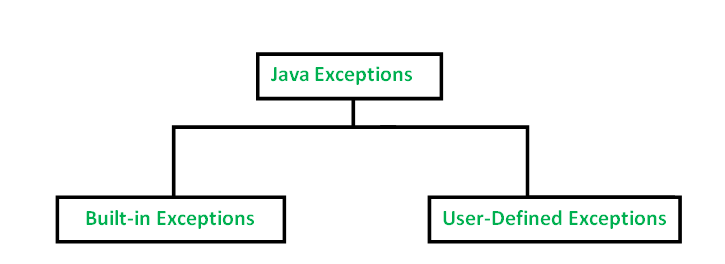Java定义了几种与其各种类库相关的异常类型。 Java还允许用户定义自己的异常。

内置异常
内置异常是Java库中可用的异常。这些异常适用于解释某些错误情况。以下是Java中重要的内置异常列表。
- ArithmeticException
在算术运算中发生异常情况时, 将抛出该异常。 - ArrayIndexOutOfBoundsException
抛出该错误以表明已使用非法索引访问了数组。索引为负或大于或等于数组的大小。 - ClassNotFoundException
当我们尝试访问未找到其定义的类时引发此异常 - FileNotFoundException
当文件不可访问或无法打开时, 引发此异常。 - IOException
输入输出操作失败或中断时抛出 - InterruptedException
当线程正在等待, 休眠或进行某些处理时, 将引发该异常, 并使其中断。 - NoSuchFieldException
当类不包含指定的字段(或变量)时引发 - NoSuchMethodException
访问未找到的方法时将抛出该错误。 - 空指针异常
当引用空对象的成员时, 引发此异常。空代表什么都没有 - NumberFormatException
当方法无法将字符串转换为数字格式时, 将引发此异常。 - RuntimeException
这表示在运行时发生的任何异常。 - StringIndexOutOfBoundsException
String类方法抛出该异常, 以指示索引比字符串的大小大
内置异常的示例:
算术异常
// Java program to demonstrate ArithmeticException
class ArithmeticException_Demo
{
public static void main(String args[])
{
try {
int a = 30 , b = 0 ;
int c = a/b; // cannot divide by zero
System.out.println ( "Result = " + c);
}
catch (ArithmeticException e) {
System.out.println ( "Can't divide a number by 0" );
}
}
}输出如下:
Can't divide a number by 0空指针异常
//Java program to demonstrate NullPointerException
class NullPointer_Demo
{
public static void main(String args[])
{
try {
String a = null ; //null value
System.out.println(a.charAt( 0 ));
} catch (NullPointerException e) {
System.out.println( "NullPointerException.." );
}
}
}输出如下:
NullPointerException..StringIndexOutOfBound异常
// Java program to demonstrate StringIndexOutOfBoundsException
class StringIndexOutOfBound_Demo
{
public static void main(String args[])
{
try {
String a = "This is like chipping " ; // length is 22
char c = a.charAt( 24 ); // accessing 25th element
System.out.println(c);
}
catch (StringIndexOutOfBoundsException e) {
System.out.println( "StringIndexOutOfBoundsException" );
}
}
}输出如下:
StringIndexOutOfBoundsExceptionFileNotFound异常
//Java program to demonstrate FileNotFoundException
import java.io.File;
import java.io.FileNotFoundException;
import java.io.FileReader;
class File_notFound_Demo {
public static void main(String args[]) {
try {
// Following file does not exist
File file = new File( "E://file.txt" );
FileReader fr = new FileReader(file);
} catch (FileNotFoundException e) {
System.out.println( "File does not exist" );
}
}
}输出如下:
File does not existNumberFormat异常
// Java program to demonstrate NumberFormatException
class NumberFormat_Demo
{
public static void main(String args[])
{
try {
// "akki" is not a number
int num = Integer.parseInt ( "akki" ) ;
System.out.println(num);
} catch (NumberFormatException e) {
System.out.println( "Number format exception" );
}
}
}输出如下:
Number format exceptionArrayIndexOutOfBounds异常
// Java program to demonstrate ArrayIndexOutOfBoundException
class ArrayIndexOutOfBound_Demo
{
public static void main(String args[])
{
try {
int a[] = new int [ 5 ];
a[ 6 ] = 9 ; // accessing 7th element in an array of
// size 5
}
catch (ArrayIndexOutOfBoundsException e){
System.out.println ( "Array Index is Out Of Bounds" );
}
}
}输出如下:
Array Index is Out Of Bounds用户定义的异常
有时, Java中的内置异常无法描述某种情况。在这种情况下, 用户还可以创建称为"用户定义的例外"的例外。
按照以下步骤创建用户定义的异常。
用户应创建一个异常类作为Exception类的子类。由于所有异常都是Exception类的子类, 因此用户还应使其类成为其子类。可以这样完成:
class MyException extends Exception我们可以在他自己的异常类中编写一个默认构造函数。
MyException(){}我们还可以创建一个以字符串为参数的参数化构造函数。
我们可以使用它来存储异常详细信息。我们可以从中调用super class(Exception)构造函数并将字符串发送到那里。
MyException(String str)
{
super(str);
}要引发用户定义类型的异常, 我们需要为其异常类创建一个对象, 并使用throw子句将其抛出, 如下所示:
MyException me = new MyException("Exception details");
throw me;- 下面的程序说明了如何创建自己的异常类MyException。
- 帐号, 客户名和余额的详细信息以三个数组的形式显示。
- 在main()方法中, 使用for循环显示详细信息。此时, 将检查任何帐户中的余额是否少于要存入该帐户的最小余额。
- 如果是这样, 则引发MyException并显示一条消息"余额不足"。
// Java program to demonstrate user defined exception
// This program throws an exception whenever balance
// amount is below Rs 1000
class MyException extends Exception
{
//store account information
private static int accno[] = { 1001 , 1002 , 1003 , 1004 };
private static String name[] =
{ "Nish" , "Shubh" , "Sush" , "Abhi" , "Akash" };
private static double bal[] =
{ 10000.00 , 12000.00 , 5600.0 , 999.00 , 1100.55 };
// default constructor
MyException() { }
// parametrized constructor
MyException(String str) { super (str); }
// write main()
public static void main(String[] args)
{
try {
// display the heading for the table
System.out.println( "ACCNO" + "\t" + "CUSTOMER" +
"\t" + "BALANCE" );
// display the actual account information
for ( int i = 0 ; i < 5 ; i++)
{
System.out.println(accno[i] + "\t" + name[i] +
"\t" + bal[i]);
// display own exception if balance < 1000
if (bal[i] < 1000 )
{
MyException me =
new MyException( "Balance is less than 1000" );
throw me;
}
}
} //end of try
catch (MyException e) {
e.printStackTrace();
}
}
}运行时错误
MyException: Balance is less than 1000
at MyException.main(fileProperty.java:36)输出如下:
ACCNO CUSTOMER BALANCE
1001 Nish 10000.0
1002 Shubh 12000.0
1003 Sush 5600.0
1004 Abhi 999.0相关文章:
- Java中的已检查与未检查异常
- 捕获基类和派生类为异常
- 异常处理测验
如果发现任何不正确的地方, 或者想分享有关上述主题的更多信息, 请写评论。

